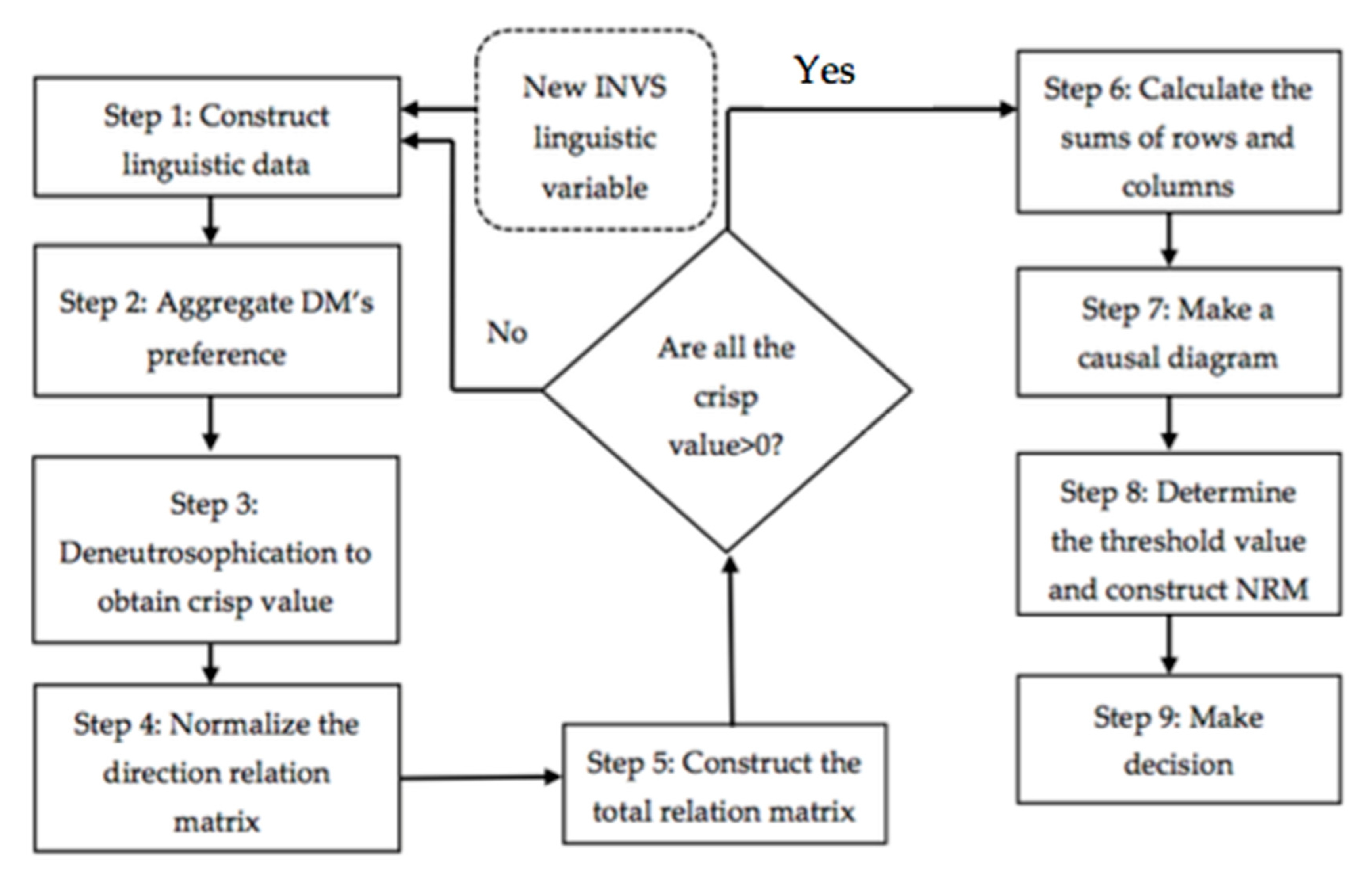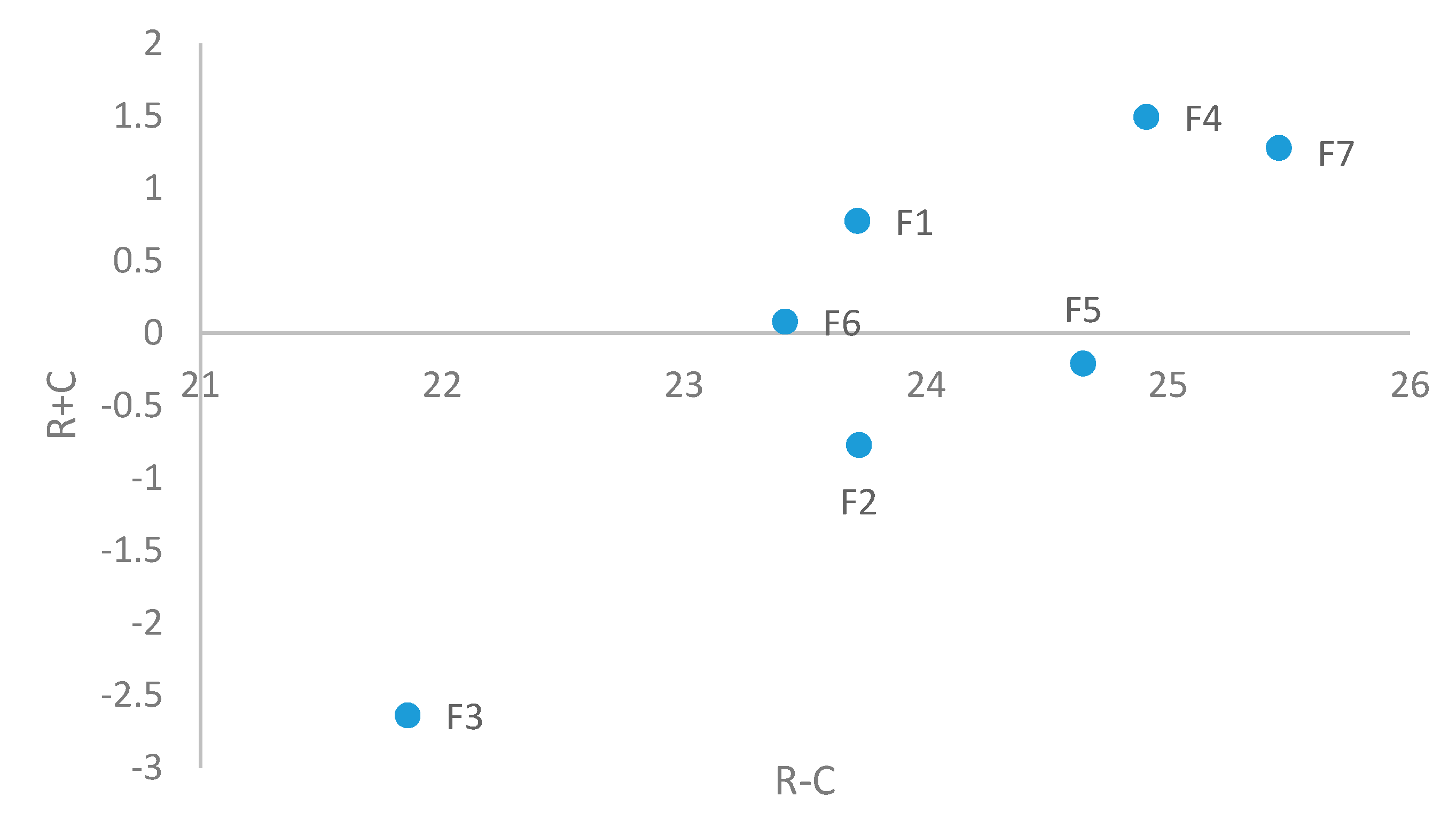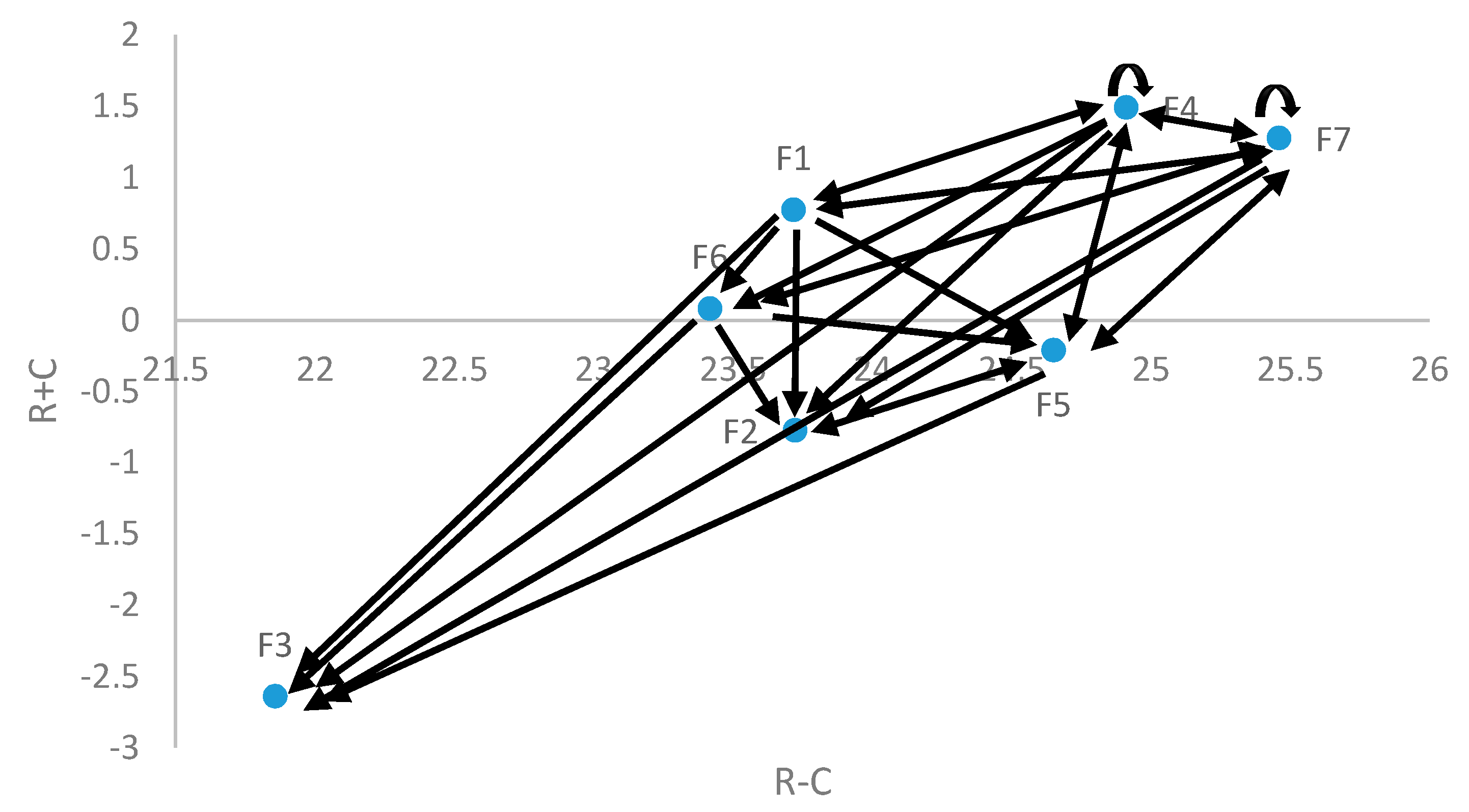A Hybrid Approach of Interval Neutrosophic Vague Sets and DEMATEL with New Linguistic Variable
Abstract
:1. Introduction
2. Preliminaries
3. Proposed Method
3.1. Construction of Linguistic Variable
- Step 1: Convert linguistic variable of INS to INVS.
- Step 2: Calculation of is obtained by condition of INVS.
- Step 3: verify the linguistic variable for INVS.
3.2. The INVS DEMATEL Procedures
- Step 1: Construct linguistic data using the new linguistic variable.
- Step 2: Aggregate DM’s preferences using the mean operator of INVS.
- Step 3: Deneutrosophication process to obtain crisp value.
- Step 4: Normalizing the direct relation matrix.
- Step 5: Constructing the INVS total relation matrix.
- Step 6: Calculating the sum of the rows and columns.
- Step 7: Construct a causal diagram.
- Step 8: Set up the threshold value and the network relationship map.
4. Illustrative Example: Hospital Service Quality
- Step 1: Construct the decision matrix with proposed INVS linguistic variable.
- Step 2: Aggregate DM’s preferences using mean operator of INVS.
- Step 3: Deneutrosophication process to obtain crisp value.
- Step 5: Construct the INVS total relation matrix.
- Step 6: Calculating the sum of the rows and columns.
- Step 7: Construct a causal diagram.
- Step 8: Setup a threshold value and construct the network relationship map.
5. Comparison Analysis
5.1. Comparative Analysis
5.2. Comparison between INVS-DEMATEL and the Existing Models
6. Conclusions
- In this research, the neutrosophic environment was used to establish the linguistic variable of the DEMATEL. The new INVS linguistic variable considers more range of value while handling uncertainty, since a new parameter is added to INS. This is accordance with recommendations by Rodríguez et al. [53]. It is useful to include the complex linguistic variable to capture information in different forms and to manage uncertainties of different types within a single framework.
- The combination of INVS and DEMATEL can manage the complex interactions between criteria.
- The insertion of a vague set with a neutrosophic set gives a new result on the degree of importance and net impact.
Author Contributions
Funding
Acknowledgments
Conflicts of Interest
References
- Gou, X.; Xu, Z.; Liao, H. Hesitant fuzzy linguistic entropy and cross-entropy measures and alternative queuing method for multiple criteria decision making. Inf. Sci. 2017, 388–389, 225–246. [Google Scholar] [CrossRef]
- Ekel, P.; Kokshenev, I.; Parreiras, R.; Pedrycz, W.; Pereira, J., Jr. Multiobjective and multiattribute decision making in a fuzzy environment and their power engineering applications. Inf. Sci. 2016, 361–362, 100–119. [Google Scholar] [CrossRef]
- Wang, J.-J.; Jing, Y.-Y.; Zhang, C.-F.; Zhao, J.-H. Review on multi-criteria decision analysis aid in sustainable energy decision-making. Renew. Sustain. Energy Rev. 2009, 13, 2263–2278. [Google Scholar] [CrossRef]
- Wan, S.; Xu, G.; Dong, J. Supplier selection using ANP and ELECTRE II in interval 2-tuple linguistic environment. Inf. Sci. 2017, 385–386, 19–38. [Google Scholar] [CrossRef]
- Rodríguez, A.; Ortega, F.; Concepción, R. An intuitionistic method for the selection of a risk management approach to information technology projects. Inf. Sci. 2017, 375, 202–218. [Google Scholar] [CrossRef]
- Kuang, H.; Kilgour, D.M.; Hipel, K.W. Grey-based PROMETHEE II with application to evaluation of source water protection strategies. Inf. Sci. 2015, 294, 376–389. [Google Scholar] [CrossRef]
- Karabasevic, D.; Popovic, G.; Stanujkic, D.; Maksimovic, M.; Sava, C. An approach for hotel type selection based on the single-valued intuitionistic fuzzy numbers. Int. Rev. 2019, 1–2, 7–14. [Google Scholar] [CrossRef] [Green Version]
- Smarandache, F. α-Discounting Method for Multi-Criteria Decision Making (α-D MCDM). In Proceedings of the 2010 13th Conference on Information Fusion (FUSION), Edinburgh, UK, 26–29 July 2010. [Google Scholar] [CrossRef]
- Gabus, A.; Fontella, E. Perceptions of the World Problematique; Battelle Institute, Geneva Research Center: Geneva, Switzerland, 1975. [Google Scholar]
- Lin, C.-J.; Wu, W.-W. A causal analytical method for group decision-making under fuzzy environment. Expert Syst. Appl. 2008, 34, 205–213. [Google Scholar] [CrossRef]
- Bai, C.; Sarkis, J. A grey-based DEMATEL model for evaluating business process management critical success factors. Int. J. Prod. Econ. 2013, 146, 281–292. [Google Scholar] [CrossRef]
- Haleem, A.; Khan, S.; Khan, M.I. Traceability implementation in food supply chain: A grey-DEMATEL approach. Inf. Process. Agric. 2019, 6, 335–348. [Google Scholar] [CrossRef]
- Cui, L.; Chan, H.K.; Zhou, Y.; Dai, J.; Lim, J.J. Exploring critical factors of green business failure based on grey-decision making trial and evaluation laboratory (DEMATEL). J. Bus. Res. 2019, 98, 450–461. [Google Scholar] [CrossRef]
- Zadeh, L.A. Fuzzy sets. Inf. Control 1965, 8, 338–353. [Google Scholar] [CrossRef] [Green Version]
- Lin, R.-J. Using fuzzy DEMATEL to evaluate the green supply chain management practices. J. Clean. Prod. 2013, 40, 32–39. [Google Scholar] [CrossRef]
- Malviya, R.K.; Kant, R. Identifying Critical Success Factors for Green Supply Chain Management Implementation Using Fuzzy DEMATEL Method. In Proceedings of the 2014 IEEE International Conference on Industrial Engineering and Engineering Management, Selangor, Malaysia, 9–12 December 2014; pp. 214–218. [Google Scholar] [CrossRef]
- Lin, K.-P.; Hung, K.-C.; Lin, R.-J. Developing Tω Fuzzy DEMATEL Method for Evaluating Green Supply Chain Management Practices. In Proceedings of the 2014 IEEE International Conference on Fuzzy Systems (FUZZ-IEEE), Beijing, China, 6–11 July 2014; pp. 1422–1427. [Google Scholar] [CrossRef]
- Akyuz, E.; Celik, E. A fuzzy DEMATEL method to evaluate critical operational hazards during gas freeing process in crude oil tankers. J. Loss Prev. Process Ind. 2015, 38, 243–253. [Google Scholar] [CrossRef]
- Atanassov, K.T. Intuitionistic fuzzy sets. Fuzzy Sets Syst. 1986, 20, 87–96. [Google Scholar] [CrossRef]
- Govindan, K.; Khodaverdi, R.; Vafadarnikjoo, A. Intuitionistic fuzzy based DEMATEL method for developing green practices and performances in a green supply chain. Expert Syst. Appl. 2015, 42, 7207–7220. [Google Scholar] [CrossRef]
- Li, Y.; Hu, Y.; Zhang, X.; Deng, Y.; Mahadevan, S. An evidential DEMATEL method to identify critical success factors in emergency management. Appl. Soft Comput. 2014, 22, 504–510. [Google Scholar] [CrossRef]
- Hosseini, M.B.; Tarokh, M.J. Type-2 fuzzy set extension of DEMATEL method combined with perceptual computing for decision making. J. Ind. Eng. Int. 2013, 9, 10. [Google Scholar] [CrossRef] [Green Version]
- Dalalah, D.; Hayajneh, M.; Batieha, F. A fuzzy multi-criteria decision making model for supplier selection. Expert Syst. Appl. 2011, 38, 8384–8391. [Google Scholar] [CrossRef]
- Abdullah, L.; Zulkifli, N. Integration of fuzzy AHP and interval Type-2 fuzzy DEMATEL: An application to human resource management. Expert Syst. Appl. 2015, 42, 4397–4409. [Google Scholar] [CrossRef]
- Baykasoğlu, A.; Gölcük, İ. Development of an interval Type-2 fuzzy sets based hierarchical MADM model by combining DEMATEL and TOPSIS. Expert Syst. Appl. 2017, 191, 194–206. [Google Scholar] [CrossRef]
- Baykasoğlu, A.; Kaplanoğlu, V.; Du, Z.D.; Şahin, C. Integrating fuzzy DEMATEL and fuzzy hierarchical TOPSIS methods for truck selection. Expert Syst. Appl. 2013, 40, 899–907. [Google Scholar] [CrossRef]
- Julong Deynrt, D. Introduction to grey system theory. Introd. Grey Syst. Theory 1989, 1, 1–24. [Google Scholar]
- Asan, U.; Kadaifci, C.; Bozdag, E.; Soyer, A.; Serdarasan, S. A new approach to DEMATEL based on interval-valued hesitant fuzzy sets. Appl. Soft Comput. 2018, 66, 34–49. [Google Scholar] [CrossRef]
- Çelikbilek, Y.; Tüysüz, F. An integrated grey based multi-criteria decision making approach for the evaluation of renewable energy sources. Energy 2016, 115, 1246–1258. [Google Scholar] [CrossRef]
- Moktadir, M.A.; Ali, S.M.; Rajesh, R.; Paul, S.K. Modeling the interrelationships among barriers to sustainable supply chain management in leather industry. J. Clean. Prod. 2018, 181, 631–651. [Google Scholar] [CrossRef]
- Bouzon, M.; Govindan, K.; Taboada, C.M. Resources, conservation and recycling evaluating barriers for reverse logistics implementation under a multiple stakeholders’ perspective analysis using grey decision making approach. Resour. Conserv. Recycl. 2018, 128, 315–335. [Google Scholar] [CrossRef]
- Tseng, M.-L.; Lin, Y.H. Application of fuzzy DEMATEL to develop a cause and effect model of municipal solid waste management in metro manila. Environ. Monit. Assess. 2009, 158, 519–533. [Google Scholar] [CrossRef]
- Ali, M.; Smarandache, F. Complex neutrosophic set. Neural Comput. Appl. 2017, 28, 1817–1834. [Google Scholar] [CrossRef] [Green Version]
- Alias, S.; Mohamad, D.; Shuib, A. Rough neutrosophic multisets relation with application in marketing strategy. Neutrosophic Sets Syst. 2018, 21, 36–55. [Google Scholar]
- Al-Quran, A.; Hassan, N. Neutrosophic vague soft set and its applications. Malays. J. Math. Sci. 2017, 11, 141–163. [Google Scholar]
- Al-Quran, A.; Hassan, N. Neutrosophic vague soft multiset for decision under uncertainty. Songklanakarin J. Sci. Technol. 2018, 40, 290–305. [Google Scholar]
- Alkhazaleh, S. Neutrosophic vague set theory. Crit. Rev. 2015, X, 29–39. [Google Scholar]
- Kumar Maji, P. Neutrosophic soft set. Ann. Fuzzy Math. Inform. 2013, 5, 157–168. [Google Scholar]
- Dung, V.; Thu Thuy, L.; Quynh Mai, P.; Van Dan, N.; Thi Mai La, N. TOPSIS approach using interval neutrosophic sets for personnel selection. Asian J. Sci. Res. 2018, 11, 434–440. [Google Scholar] [CrossRef]
- Biswas, P.; Pramanik, S.; Giri, B.C. TOPSIS method for multi-attribute group decision-making under single-valued neutrosophic environment. Neural Comput. Appl. 2016, 27, 727–737. [Google Scholar] [CrossRef]
- Abdel-Basset, M.; Mohamed, M.; Sangaiah, A.K. Neutrosophic AHP-delphi group decision making model based on trapezoidal neutrosophic numbers. J. Ambient Intell. Humaniz. Comput. 2018, 9, 1427–1443. [Google Scholar] [CrossRef] [Green Version]
- Pamučar, D.; Sremac, S.; Stević, Ž.; Ćirović, G.; Tomić, D. New multi-criteria LNN WASPAS model for evaluating the work of advisors in the transport of hazardous goods. Neural Comput. Appl. 2019, 31, 5045–5068. [Google Scholar] [CrossRef]
- Abdel-Baset, M.; Chang, V.; Gamal, A.; Smarandache, F. An integrated neutrosophic ANP and VIKOR method for achieving sustainable supplier selection: A case study in importing field. Comput. Ind. 2019, 106, 94–110. [Google Scholar] [CrossRef]
- Si, S.L.; You, X.Y.; Liu, H.C.; Zhang, P. DEMATEL technique: A systematic review of the state-of-the-art literature on methodologies and applications. Math. Probl. Eng. 2018, 2018, 1–33. [Google Scholar] [CrossRef] [Green Version]
- Abdel-Basset, M.; Manogaran, G.; Gamal, A.; Smarandache, F. A hybrid approach of neutrosophic sets and DEMATEL method for developing supplier selection criteria. Des. Autom. Embed. Syst. 2018, 22, 257–278. [Google Scholar] [CrossRef] [Green Version]
- Herrera, F.; Herrera-Viedma, E.; Martínez, L. A fusion approach for managing multi-granularity linguistic term sets in decision making. Fuzzy Sets Syst. 2000, 114, 43–58. [Google Scholar] [CrossRef]
- Wei, D.; Liu, H.; Shi, K. What are the key barriers for the further development of shale gas in china? A grey-DEMATEL approach. Energy Rep. 2019, 5, 298–304. [Google Scholar] [CrossRef]
- Wang, H.; Smarandache, F.; Zhang, Y.-Q.; Sunderraman, R. Interval Neutrosophic Sets and Logic: Theory and Applications in Computing; HEXIS: Phoenix, AZ, USA, 2005. [Google Scholar]
- Hashim, H.; Abdullah, L.; Al-Quran, A. Interval neutrosophic vague sets. Neutrosophic Sets Syst. 2019, 25, 66–75. [Google Scholar]
- Kobryń, A. DEMATEL as a weighting method in multi-criteria decision analysis. Mult. Criteria Decis. Mak. 2017, 12, 153–167. [Google Scholar] [CrossRef] [Green Version]
- Shieh, J.-I.; Wu, H.-H.; Huang, K.-K. A DEMATEL method in identifying key success factors of hospital service quality. Knowl. Based Syst. 2010, 23, 277–282. [Google Scholar] [CrossRef]
- Chen, N.; Xu, Z.; Xia, M. Interval-valued hesitant preference relations and their applications to group decision making. Knowl. Based Syst. 2013, 37, 528–540. [Google Scholar] [CrossRef]
- Rodríguez, R.M.; Labella, Á.; Martínez, L. An overview on fuzzy modelling of complex linguistic preferences in decision making. Int. J. Comput. Intell. Syst. 2016, 9, 81–94. [Google Scholar] [CrossRef] [Green Version]



| Linguistic Variable | Interval Neutrosophic Set |
|---|---|
| No Influence (NI) | |
| Very Low Influence (LI) | |
| Medium Influence (MI) | |
| High Influence (HI) | |
| Absolutely Influence (AI) |
| Linguistic Variable | Interval Neutrosophic Vague Set |
|---|---|
| No Influence (NI) | |
| Very Low Influence (LI) | |
| Medium Influence (MI) | |
| High Influence (HI) | |
| Absolutely Influence (AI) |
| 0 | HI, MI, MI | MI, MI, HI | LI, HI, MI | MI, LI, HI | MI, AI, HI | NI, HI, MI | |
| MI, LI, HI | 0 | MI, AI, LI | HI, HI, NI | HI, HI, MI | LI, MI, HI | LI, HI, MI | |
| M, VU, M | NI, MI, NI | 0 | HI, NI, LI | NI, MI, AI | NI, MI, HI | HI, MI, LI | |
| HI, HI, MI | MI, AI, HI | LI, MI, MI | 0 | MI, HI, AI | NI, HI, MI | NI, AI, HI | |
| HI, MI, MI | MI, NI, AI | MI, MI, HI | HI, MI, MI | 0 | NI, MI, HI | AI, HI, MI | |
| MI, NI, MI | HI, MI, MI | MI, NI, AI | LI, HI, MI | MI, MI, MI | 0 | LI, MI, AI | |
| HI, MI, LI | AI, HI, MI | LI, VI, LI | HI, HI, MI | AI, HI, NI | MI, HI, AI | 0 |
| 0.0000 | 1.2461 | 1.2461 | 1.1022 | 1.1022 | 1.4383 | 0.9911 | 7.1261 | |
| 1.1022 | 0.0000 | 1.1789 | 1.0833 | 1.3519 | 1.1789 | 1.1022 | 6.9975 | |
| 0.9011 | 0.7169 | 0.0000 | 0.8756 | 1.0589 | 0.7169 | 1.1022 | 5.3717 | |
| 1.3519 | 1.4383 | 1.0044 | 0.0000 | 1.4383 | 0.9911 | 1.1528 | 7.3769 | |
| 1.2461 | 1.0589 | 1.2461 | 1.2461 | 0.0000 | 0.9911 | 1.4383 | 7.2267 | |
| 0.9011 | 1.2461 | 1.0589 | 1.1022 | 1.1425 | 0.0000 | 1.1789 | 6.6297 | |
| 1.1022 | 1.4383 | 1.0408 | 1.3519 | 1.1528 | 1.4383 | 0.0000 | 7.5244 |
| 0.0000 | 0.1656 | 0.1656 | 0.1465 | 0.1465 | 0.1912 | 0.1317 | |
| 0.1465 | 0.0000 | 0.1567 | 0.1440 | 0.1797 | 0.1567 | 0.1465 | |
| 0.1198 | 0.0953 | 0.0000 | 0.1164 | 0.1407 | 0.0953 | 0.1465 | |
| 0.1797 | 0.1912 | 0.1335 | 0.0000 | 0.1912 | 0.1317 | 0.1532 | |
| 0.1656 | 0.1407 | 0.1656 | 0.1656 | 0.0000 | 0.1317 | 0.1912 | |
| 0.1198 | 0.1656 | 0.1407 | 0.1465 | 0.1518 | 0.0000 | 0.1567 | |
| 0.1465 | 0.1912 | 0.1383 | 0.1797 | 0.1532 | 0.1912 | 0.0000 |
| 1.562 | 1.8104 | 1.8104 | 1.7226 | 1.8214 | 1.7509 | 1.768 | |
| 1.5936 | 1.5657 | 1.6528 | 1.6225 | 1.7405 | 1.627 | 1.6726 | |
| 1.3341 | 1.3978 | 1.3108 | 1.3572 | 1.4518 | 1.336 | 1.4209 | |
| 1.8383 | 1.9587 | 1.9587 | 1.7196 | 1.9871 | 1.83 | 1.9091 | |
| 1.7028 | 1.7904 | 1.7904 | 1.7354 | 1.6903 | 1.7048 | 1.8053 | |
| 1.6069 | 1.7427 | 1.7427 | 1.6584 | 1.757 | 1.5243 | 1.7163 | |
| 1.8336 | 1.9825 | 1.9825 | 1.8937 | 1.9824 | 1.8957 | 1.7983 |
| Rank of Importance | Rank of Effect | Cause/Effect | |||||
|---|---|---|---|---|---|---|---|
| 12.2457 | 11.4713 | 23.717 | 5 | 0.7744 | 4 | Cause | |
| 11.4747 | 12.2482 | 23.7229 | 4 | −0.7735 | 6 | Effect | |
| 9.6086 | 12.2483 | 21.8569 | 7 | −2.6397 | 7 | Effect | |
| 13.2015 | 11.7094 | 24.9109 | 2 | 1.4921 | 1 | Cause | |
| 12.2194 | 12.4305 | 24.6499 | 3 | −0.2111 | 5 | Effect | |
| 11.7483 | 11.6687 | 23.417 | 6 | 0.0796 | 3 | Cause | |
| 13.3687 | 12.0905 | 25.4592 | 1 | 1.2782 | 2 | Cause |
| 0 | 1 | 1 | 1 | 1 | 1 | 1 | |
| 0 | 0 | 0 | 0 | 1 | 0 | 0 | |
| 0 | 0 | 0 | 0 | 0 | 0 | 0 | |
| 1 | 1 | 1 | 1 | 1 | 1 | 1 | |
| 0 | 1 | 1 | 1 | 0 | 0 | 1 | |
| 0 | 1 | 1 | 0 | 1 | 0 | 1 | |
| 1 | 1 | 1 | 1 | 1 | 1 | 1 |
| Type of Assessment | Degree of Importance & Net Impact |
|---|---|
| INVS-DEMATEL with new linguistic variable (proposed method) | Cause criterion: , , , Effect criterion: , , |
| Neutrosophic DEMATEL | Cause criterion: , , Effect criterion: , , , |
| DEMATEL | Cause criterion: , , Effect criterion: , , , |
© 2020 by the authors. Licensee MDPI, Basel, Switzerland. This article is an open access article distributed under the terms and conditions of the Creative Commons Attribution (CC BY) license (http://creativecommons.org/licenses/by/4.0/).
Share and Cite
Al-Quran, A.; Hashim, H.; Abdullah, L. A Hybrid Approach of Interval Neutrosophic Vague Sets and DEMATEL with New Linguistic Variable. Symmetry 2020, 12, 275. https://doi.org/10.3390/sym12020275
Al-Quran A, Hashim H, Abdullah L. A Hybrid Approach of Interval Neutrosophic Vague Sets and DEMATEL with New Linguistic Variable. Symmetry. 2020; 12(2):275. https://doi.org/10.3390/sym12020275
Chicago/Turabian StyleAl-Quran, Ashraf, Hazwani Hashim, and Lazim Abdullah. 2020. "A Hybrid Approach of Interval Neutrosophic Vague Sets and DEMATEL with New Linguistic Variable" Symmetry 12, no. 2: 275. https://doi.org/10.3390/sym12020275





